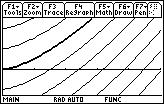This lesson exlores the relationship between antiderivatives and indefinite integrals and discusses families of curves.
Mathematics can be discovered using the TI-89, as illustrated in Module 2 and Module 10. There is a sense of ownership and interest that is acquired with inductive learning. Review the discovery-learning process which was described in Module 2 and Module 10 and is shown below.
- Explore several related examples
- Describe verbally the pattern of the results
- Predict the result
- Confirm the prediction
- Extend the types of examples explored
- Generalize
Defining Indefinite Integrals
Recall that an antiderivative of a function f is a function F whose derivative is
![]() .
.
The Fundamental theorem gives a relationship between an antiderivative F and the function f.
![]() , where F'(x) = f(x) and a is any constant.
, where F'(x) = f(x) and a is any constant.
A modified notation is used to signify the antiderivatives of f. The new notation is called an indefinite integral and the antiderivatives of f are written as
![]()
|
|||
|
|
|||
Using the Integral Key
The integral key, which is used to find definite integrals, can also be used to find indefinite integrals by simply omitting the limits of integration.
|
|||
|
|
|||
Exploring
![]()
Examine the antiderivative of each of the following functions that have the form xn and look for a pattern that will lead you to a general rule for finding
![]() .
.
-
Evaluate

-
Evaluate

-
Evaluate

Notice that the arbitrary constant C is not part of the result given by the TI-89.
|
|||
|
|
|||
Describing the Pattern and Predicting
18.1.1 Describe the pattern you found when evaluating the indefinite integrals above and use it to predict
![]() .
.
Click here for the answer.
18.1.2 Confirm your prediction of
![]() on your TI-89.
on your TI-89.
Click here for the answer.
Extending the Examples
Extend the exploration of examples by predicting the following indefinite integrals.
-
Evaluate

-
Evaluate

18.1.3 Confirm your predictions by entering the integrals on your TI-89.
Click here for the answer.
Generalizing the Pattern
18.1.4 Predict a general rule for
![]() and confirm it by entering the integral on your TI-89.
and confirm it by entering the integral on your TI-89.
Click here for the answer.
Checking Indefinite Integrals
Because
![]() you can check each indefinite integral's result by finding the derivative of the result. For example,
you can check each indefinite integral's result by finding the derivative of the result. For example,
![]() can be verified by taking the derivative of the result:
can be verified by taking the derivative of the result:
![]() . Because the result of the differentiation is the original function, the integration is confirmed.
. Because the result of the differentiation is the original function, the integration is confirmed.
The Generalized Rule
The generalized version of this rule is
![]() , where
, where
![]() and C is a constant. Recall that the derivative of a constant is 0, so
and C is a constant. Recall that the derivative of a constant is 0, so
![]() for any constant C.
for any constant C.
Illustrating
![]()
The indefinite integral
![]() may be illustrated by graphing the family of curves that are represented by
may be illustrated by graphing the family of curves that are represented by
![]() for different values of C. For example,
for different values of C. For example,
![]() corresponds to
corresponds to
![]() . Letting C take the values -240, -200, -160, -120, -80, -40, 0, 40, 80, the family of curves is shown below in a [0, 50] x [-50, 100] window where the particular curve associated with
. Letting C take the values -240, -200, -160, -120, -80, -40, 0, 40, 80, the family of curves is shown below in a [0, 50] x [-50, 100] window where the particular curve associated with

Each curve in the family can be obtained by choosing a different value of C and vertically translating the curve corresponding to C = 0.